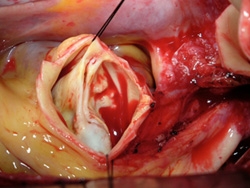Guide to Bicuspid Valve Disease
 Bicuspid aortic valve (BAV) is the most common birth defect affecting the heart and is present in 1-2% of the population. Bicuspid aortic valve is much more common in males than females.
Bicuspid aortic valve (BAV) is the most common birth defect affecting the heart and is present in 1-2% of the population. Bicuspid aortic valve is much more common in males than females.
There are three main forms of bicuspid aortic valve disease, as classified by Hans Sievers, MD in 2007. These types vary according to the number of 'cusps' and 'raphes' (arrow-shaped formations of tissue, also called 'false commissures'), and their position and functional status. 'Cusps' refer to the tips in the valve. 'Raphes' refer to the fused areas where undeveloped cusps form a malformed commissure, and appear like ridges with elastic fibers.
Types of bicuspid aortic valve:
- Type 0: no raphes (so-called 'purely' BAV)
- Type 1: 1 raphe
- Type 2: 2 raphes
Bicuspid Aortic Valve and Risk of Aneurysm
In a bicuspid aortic valve, the valve leaflets do not open as fully they should. This causes turbulence as the blood flows through the valve. It creates areas around the valve where blood stagnates a bit, and other areas around the valve where the blood is under high pressure. This imbalance puts an abnormal amount of pressure on the valve, which sets the stage for damage to occur. Once damage occurs, the areas of stagnation or pooling will allow calcium to deposit on the valve. This will result in thickening and incomplete opening. This process continues until the valve is destroyed. It is important to note that not everyone with a bicuspid valve will have this problem, but that there is an increased likelihood of calcium deposits forming on the leaflets. It is important to note that the risk of developing bicuspid aortic valve has a genetic basis. Anyone who has a relative who had a bicuspid valve, an aneurysm, or a dissection should have an echocardiogram to assess the structure and function of their aortic valve.
Valve Replacement for Patients with Bicuspid Valve
Replacement of the aortic root at the time of valve replacement is recommended for patients who have bicuspid valve disease for several reasons. Aortic aneurysms develop in half of patients with bicuspid valves, and dissection occurs in 5%. Put in another perspective, bicuspid valve disease increases the risk of aortic dissection nine-fold. Moreover, replacing just the valve does not eliminate the risk of aortic dissection or aneurysm.
In general, the course of treatment for patients with bicuspid valve is determined by the condition of both the valve and the root. Since they are closely related, but may develop surgical indications at different rates, we generally think of the valve and the root as one, yet account for variations in disease progression. The goal of surgery is simple: to make patients feel better, to preserve both quality and length of life, and to limit treatment to a single operation so that patients do not need to undergo multiple procedures.
With these factors in mind, we may consider the following options for bicuspid valve patients. If the patient's own valve can be rebuilt and made to function perfectly, then we will perform surgical repair. Since bicuspid valves do not enjoy the same function as a trileaflet valve, we are exceptionally careful to perform a responsible repair that will give the patient a long-lasting result.
In the event that the valve cannot be effectively repaired, several new valves are available. The choice of an aortic valve must be made by the patient and the patient's family, with input from the cardiac surgeon and cardiologist. At NYP/Columbia we stock every FDA approved mechanical and tissue valve. The most important consideration for the patient is whether to choose a tissue or mechanical valve. The decision is based on whether the patient wants to avoid any further valve procedure versus the need to take a blood thinner (anticoagulant medication such as Coumadin). After receiving a mechanical valve, patients must take blood thinners for the rest of their lives in order to prevent clots. Replacement with a tissue valve does not require taking blood thinners, but these are less durable and may require reoperation after 15 or 20 years.
The choice of valve will therefore be influenced by factors including the patient's age, health status, lifestyle, and others. For example, if the patient is a woman who wishes to have children, taking a blood thinner must be avoided, as blood thinning medications increase the risk of significant birth defects. If the patient is an active individual who enjoys contact sports, skiing, or working with tools, a blood thinner should be avoided so that injuries will not lead to dangerous bleeding problems. If the patient is not particularly active with contact sports, and wishes to avoid an additional procedure in the future, 20 then a mechanical valve is a good option. It is important to realize that regardless of which valve is chosen, the details of the operation are identical.
Next Steps
If you are in need of help for an aortic condition, we’re here for you. Call us now at (212) 305-6380 or fill out our online form to get started today.
Related Topics
- All About the Aorta
- Aortic Valve Disease
- Aortic Aneurysms
- Aortic Dissection
- Penetrating Ulcer
- Connective Tissue Disease
- Aortic Valve Repair and Ross Procedure
- Columbia Bioroot
- Hybrid Arch Surgery
- Valve Sparing Aortic Root Replacement (David Procedure)
- Minimally Invasive and Endovascular Aortic Procedures
